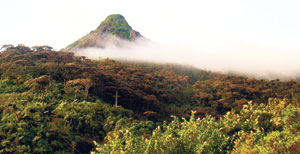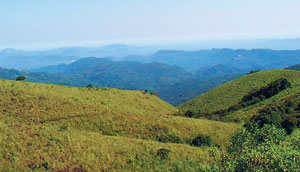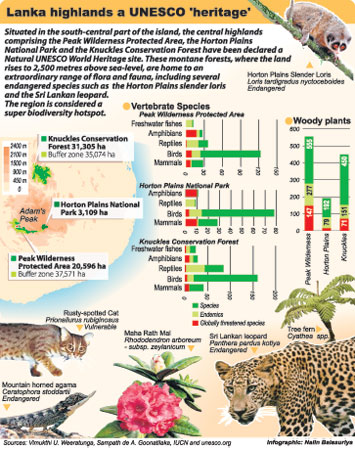It was barely two weeks ago that the media reported a rare find that hit the headlines around the world. A tiny mammal that many feared was extinct - the Montane Slender Loris. But more significant news was to come – on July 31 came the announcement that the Central Highlands of Sri Lanka which is also the home of this rare animal has been declared a UNESCO World Heritage Site- recognition of its international importance. The area identified includes the Peak Wilderness Protected Area, the Horton Plains National Park and the Knuckles Conservation Forest.
A UNESCO World Heritage Site is a place (a forest, mountain, lake, desert, monument, building, complex, or city) that is listed by UNESCO as of special cultural or physical significance. The list is maintained by the International World Heritage Programme administered by the UNESCO World Heritage Committee.
 |
| Peak wilderness and (below) scene from Knuckles range |
 |
The programme was founded with the Convention Concerning the Protection of World Cultural and Natural Heritage, which was adopted by the General Conference of UNESCO on November 16, 1972. Since then, 186 state parties have ratified the convention including Sri Lanka which became a member in 1980. The World Heritage list currently includes 911 properties in 149 countries around the world that the committee deems as having "outstanding universal value". The sites consist of 704 cultural sites, 180 with natural significance and 27 that have both. The Central Highlands of Sri Lanka has been inscribed as a natural site.
“The region is considered a super biodiversity hotspot,” noted the press release from UNESCO announcing the inclusion of Sri Lanka’s Central Highlands to the prestigious list. The declaration was announced by UNESCO's World Heritage Committee (WHC) at its 34th Session in the Brazilian capital, Brasilia. The other natural site to be listed was Papahanumokuakea in Hawaii, USA.
Deputy Minister of Environment Faiszer Musthapha who led the team of delegates to push Sri Lanka’s proposal that was evaluated along with many submissions by other countries, was jubilant. that Sri Lanka’s proposal was finally accepted unanimously. Convincing the committee was not an easy task, he told the Sunday Times.
The Central Highlands was initially proposed as a World Heritage site for both its cultural and natural value.
However there were technical difficulties in getting the site declared a ‘Mixed’ World Heritage site. The Sri Lankan team had to hence re-submit the proposal dropping the cultural tag, and push the case on the area’s natural importance alone. “This is also unique where the World Heritage Committee agreed to consider the proposal under a changed criterion,” said the Deputy Minister.
As per the UNESCO convention the site should be of universal value and meet at least one of ten selection criteria. This includes “to contain the most important and significant natural habitats for in-situ conservation of biological diversity, including those containing threatened species of outstanding universal value from the point of view of science or conservation.”
The criteria is stringent, but the Central Highlands’ natural wealth is indeed unique enough to justify its inclusion. "40-50% plants found in the Central Highlands are endemic to the island emphasizing this site’s importance,” pointed out Dr. Siril Wijesundara, Director General of Sri Lanka Botanical Gardens Departments. Dr. Wijesundara pointed out instances of some plants seen only in certain mountainous areas; for instance, the Hortonia ovalifolia can only be found in the Peak wilderness while a related species Hortonia floribunda is found only in Knuckles and Horton Plains.
The Central Highlands is also home to a variety of mammals including the Sambur, Leopard, primates and many small mammals. Like the Montane Slender Loris, the area is home to the Bear Monkey – the highland race of the endemic Purple-faced Leaf Monkey. Elephants once roamed these areas too before they were hunted down by the British. However, the Peak Wilderness still has a small herd of elephants.
The avi-fauna diversity in the region is also high with many endemics found only in the hill country like the Whistling Thrush, Bush Warbler, Yellow-eared Bulbul, Dull-blue Flycatcher, Sri Lanka White-eye and the Wood Pigeon.
The UNESCO declaration is also significant given that the Central Highlands is probably the most threatened ecosystem in the country. These sites – Horton Plains, Peak Wilderness and Knuckles are believed to have been a large forest area in centuries past. But under colonial rule, many of the pristine forests were felled.
Even at present the rapid expansion of vegetable gardens threatens the natural forests, with illicit gem mining, felling of trees etc being other direct human threats. Invasive alien species and the phenomenon of some trees mysteriously dying have worried environmentalists. Many of Sri Lanka’s major rivers too spring from here with the area being a major hydro catchment site.
The timely declaration of the Central Highlands as a UNESCO World Heritage site will hopefully result in much needed protection and conservation with its importance now receiving international attention.
Behind the scenes
The process of proposing the Central Highlands as a World Heritage site was a complex team effort. The Man & Biosphere Committee operating under the National Science Foundation initiated the process as far back as 2004 with the committee being chaired at that time by Lesley Wijesinghe. Secretary Anusha Amarasinghe had also put in enormous effort to see their work finally bear fruit.
A dossier prepared by Dr. Jini Dela with a team of subject experts helped to convince the World Heritage Committee to give a favourable decision to Sri Lanka too. The committee was also supported by Saroja Sirisena and the Environmental Ministry.
World Heritage sites in Sri Lanka
Cultural
- Ancient City of Polonnaruwa (1982)
- Ancient City of Sigiriya (1982)
- Golden Temple of Dambulla (1991)
- Old Town of Galle and its Fortifications (1988)
- Sacred City of Anuradhapura (1982)
- Sacred City of Kandy (1988)
Natural
- Central Highlands of Sri Lanka (2010)
- Sinharaja Forest Reserve (1988)
|




